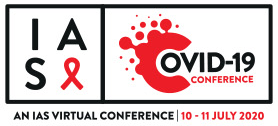Conference opening and making sense of the science
22 July 2020. Related: Conference reports, COVID-19, IAS COVID-19 virtual 2020.
 Simon Collins, HIV i-Base
Simon Collins, HIV i-Base
Introduction and background
This conference was opened by Dr Anton Pozniak, IAS head and co-chair of AIDS 2020 and Dr Tedros Adhanom Ghebreyesus, Director-General of the World Health Organization (WHO) set the background for the workshop. This included parallels between HIV and COVID-19 and acknowledging the talk from Nkosi Johnson 20 years ago at the IAS conference in Durban.
https://www.youtube.com/watch?v=rh9KIo4MWps (webcast)
The notes below summarise the next three talks from leading experts in global health provided overviews of different aspects of COVID-19 under the heading ‘making sense of the science’. A common theme included the importance of community engagement in campaigns to reduce further incidence.
https://www.youtube.com/watch?v=yMuZVyURYxg (webcast)
Global summary of COVID-19
Anthony Fauci, NIAID
Dr Anthony Fauci provided an overview of the rapid development of COVID-19 into a global pandemic that is continuing to get worse.
SARS-CoV-2 transmission – largely via droplets, but airborne risk is likely to have some role – occurs in perhaps 40-45% of cases from people likely to be asymptomatic, with an incubation period of 4-5 days but out to 14 days.
Early flu-like symptoms include fever, cough, fatigue, shortness of breath, myalgia but also loss of smell/taste etc that can precede onset. The range of responses from the same virus ranges from asymptomatic to mild/moderate, severe (80%) (14%) and critical (5%) with fatal outcomes in 1%). Older age is a predominant risk, with underlying medical conditions strongly associated with outcomes – complicated by race/ethnicity and higher risk employment.
In covering the range of therapeutic approaches, remdesivir was referred to as “a significant but modest impact on recovery”, whereas dexamethasone reduces mortality in advanced disease requiring oxygen and ventilation with no supportive data for earlier stages of infection.
The strategic approach to vaccines includes supporting research into multiple lead compounds with the need and hope that several different approaches will all be effective. Several phase 3 studies have either started or are imminent – and the importance of planning for massive scale-up to meet the global need.
Origin of COVID-19 and response in South Africa
Salim Abdool Karim, CAPRISA
SARS-CoV-2 is distinguished from related infections – SARS-1 and MERS are similar bat coronaviruses spread through intermediate animal hosts – by the high affinity ACE2 receptor binding capability of the spike protein. This difference enabled SARS-CoV-2 to spread so rapidly and extensively from human to human, with more than 10 million infections globally, within a few months.
- Person to person spread is due to many cells in the nose and back of throat having ACE2 receptors – making transmission easily spread. One example of the risk from prolonged close contact at work comes from 79/137 (58%) employees at a call centre catching SARS-CoV-2 – from one initial source infection.
- Transmission via infectious surfaces – for example, with virus on stainless steel and plastics remaining infectious for 3-4 days. In a hospital setting this will include bed rails, light switches, medical equipment etc. The risk then comes from self-inoculation when individuals touch their face.
- Airborne risk – aerosols 5 microns or less that survive in air play an uncertain but definite role. An example showing this risk included diners at a restaurant becoming infected based on direction of air from air conditioning.
Based on current data, the large close-crowded Black Lives Matter demonstrations did not lead to more infections, with protection linked to these being outside vs confined spaces.
While the prevention toolbox includes social distancing, hand hygiene and cloth masks as main stays, with environmental cleaning, testing and isolation.
Using data to drive the US response
Deborah Birx, US Ambassador
This talk emphasised the importance of engaging community responses – including testing by people without symptoms – and was informed by data from the significant and serious continued US epidemic.
The US is a high income setting, with high mortality, linked to an older population and higher comorbidities. US data is tracked by state and county, following new infections and changes in percentage of positive results with tailored prevention responses based on local incidence. Some states have counties with upwards of 20% positivity and others still report zero cases.
In the US, as with many other countries, the most vulnerable populations include the poorest (income <$25 pa), race (native Americans, Latin and African American) and those with comorbidities.
As with HIV, reducing new infections depends on community responses that brings testing to asymptomatic people from communities at higher risk. Daily data summaries identify highest risk areas to prioritise prevention interventions including pooled testing in households, schools and other community settings.

